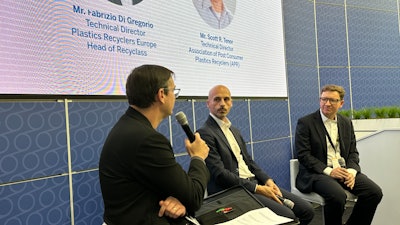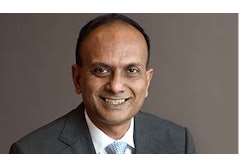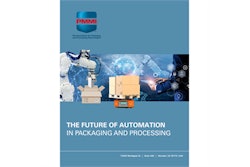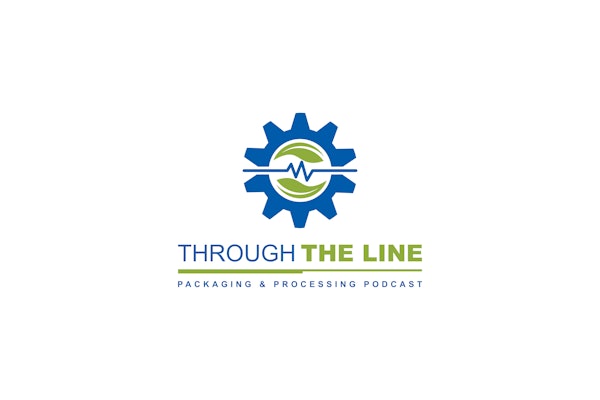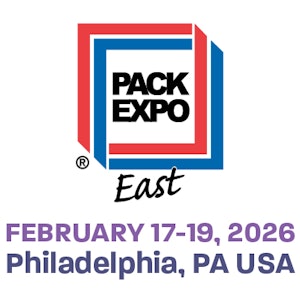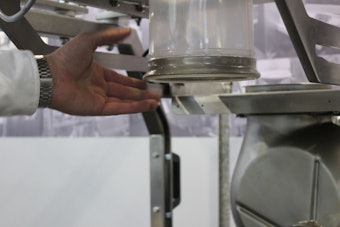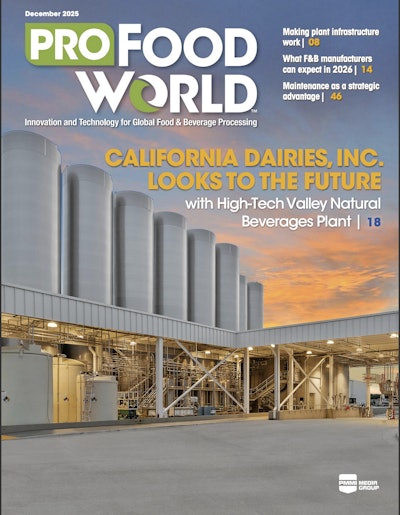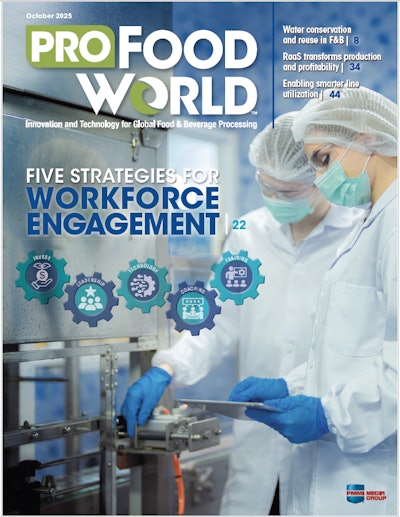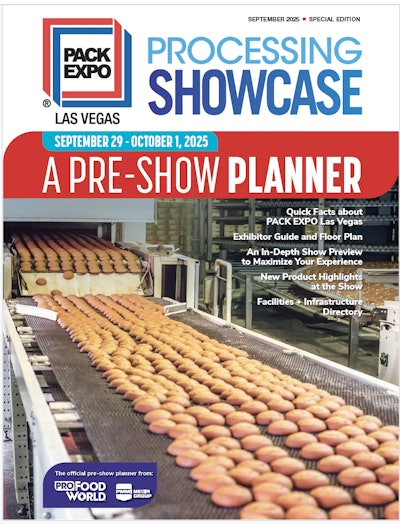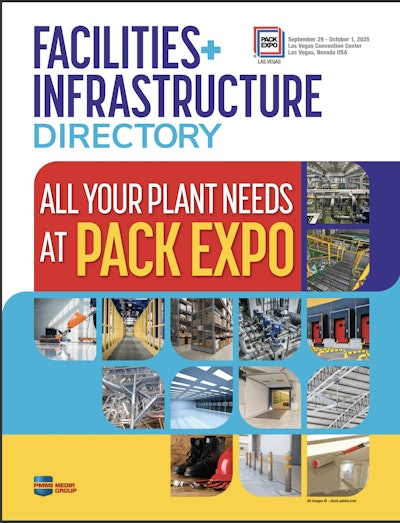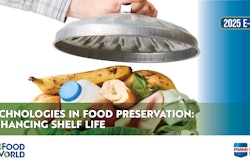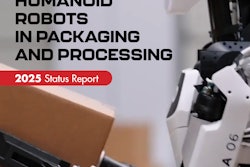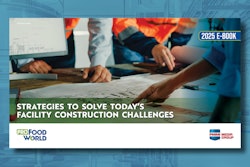Recycling in general, and specifically plastic recycling, is notoriously fragmented in the U.S., and lacks the legislative impetus to harmonize at the federal level. European systems had once suffered the same decentralized lack of alignment, but recent legislation under the European Green Deal is changing that.
While the EU and the U.S. are at different points of their journey toward alignment and harmonization within, both parties are already looking to align with one another as well, hopefully accelerating U.S. alignment.
Announced yesterday at interpack 2023, the APR in the U.S. and Recyclass from Plastic Recyclers Europe signed collaboration agreement in order to align their recycling guidelines, testing protocols, send the methodology behind the recyclability assessment by February, 2024.
Scott Trenor, technical director at the Association of Post Consumer Plastics Recyclers (APR), and Fabrizio Di Gregorio, technical director at Plastics Recyclers Europe and head of Recyclass, spoke at the Taghleef Industries booth at interpack 2023 about increasing alignment.
What follows is a transcript of their conversation with those two, as moderated by Packaging Europe's Tim Sykes.
Commonalities between systems
Scott Trenor:
I think if we start with commonalities and we'll dig into this more later, I think essentially if you look at rigid PET, rigid polypropylene, rigid HDPE films, that's about 80% of the packaging in the market. The formats are pretty similar between here. They're obviously larger containers in the US, like our gallon milk jugs when you don't drink gallon milk out of jugs here. But that part of the process, and we'll talk more about it, and the harmonization part is relatively similar, where the bigger difference is ours in collection in the US. So we are much more decentralized. They're on the order of I think 9,000 different recycling programs in North America and they all have different collection systems. They all collect different types of materials and it really makes it difficult for MRFs (Material Recovery Facilities) and others to scale technologies
Fabrizio Di Gregorio:
In Europe. As you know, the situation is quite challenging because we have on the table a proposal for repackaging project waste regulation that is quite ambitious because from January the first 2030, all packaging on the market should be recyclable and the recyclability assessment should be defined into scientific business criteria. So Recyclass is willing to contribute to the definition of this criteria. And at the same time, to really get the circularity for plastics.
In Europe, we have this proposal to have mandate in recycling plastics in whatever plastic packaging on the market. So as Scott said, when we talk about packaging and in particular plastic packaging, the structures looks like very similar to each other. In particular for rigid PET, HDPE, but also for flexibles, where a lot of multi layers materials are still on the market. But what it's probably the main difference is that in Europe now the legislator is really shifting the paradigm mark from the linear economy to the circular economy. And the only way to move to a circular economy is to keep the value in waste, to obtain the ability to recycle these waste in new vessels that can diminish the dependency of virgin in the same sector. So the goal is really to go packaging to packaging and probably this is the main difference today between US and European when it comes to recyclability.
Scott Trenor:
Yeah, I was just going to say, I mean we just don't have the government push across the entire US. So California, Oregon, Washington, northeast United States, getting to where Europe was probably 15 years ago. So we have a lot to learn from the regulatory push that you're getting here.
Moderator, Packaging Europe:
So quite different in some key aspects. I'd like to explore the idea of harmonization between the two continents, that to what extent, first of all, do you think it would be of benefit to both continents and globally to have a more harmonized system closer, we haven't even talked actually about the recycling guidelines and understanding what's recyclable, but could you talk a bit about how much harmonization we have at the moment and how much we need?
Fabrizio Di Gregorio:
Yes. Let's start from Europe. In Europe is probably everywhere. Everyone knows very well the situation is quite well fragmented, where in each country we have different design for recycling criteria. And this is because the criteria are opinion based. So this structure for me is recyclable for me is not. So the same packaging is classified as recyclable in Germany, not recyclable in Spain. Of course, this is not a scientific based approach and this will never contribute to [inaudible 00:03:57] . But we are now in a phase where we are going in Europe to standardize the design for recycling criteria. And what I discussed a lot of times with Scott, the market is a global market.
In Europe we are moving faster because the lives better. We have an extra push, but at the end of the day, the players are global players. So in order to support the global players, we need in any case to harmonize the vision, harmonize, standardize the testing protocols and the design for second criteria as much as we can. So we can copy paste each other, but we can share data and direct experience in order to accelerate, give a boost to the definition and the standardization of such a good deal.
Scott Trenor:
Yeah and if you're a global brand, you don't want to be making different packaging selections for various individual countries or you know want a global package that you can ship easily anywhere. So getting to similar guidelines for recyclability, similar package designs really enables brands to simplify their supply chain.
Institutional and Cultural Factors
Moderator, Packaging Europe:
Great. So collaboration and closer harmonization is clearly something that we should all be working for. Let's think about what are the ways that we can do that and what are the barriers in doing so? First of all, when it comes to institutional and cultural factors, how do you see that fabric?
Fabrizio Di Gregorio:
Yeah, first of all probably could be very good to announce also today that in February, APR, the Association of Plastic Recyclers in US and Recyclass from Plastic Recyclers Europe has signed at an official collaboration agreement in order to align as much as we can the design for reciting guidelines, the testing protocol, send the methodology behind the recyclability assessment by February, 2024. So in one year, and we are really working together, the two teams also APR colleagues are invited to join the technical committees Recyclass and Recyclass team is invited to join the APR Technical Committees in order to further share data and experience to each other and give an extra boost to the harmonization. In terms of different cultural differences, yes, I think the main driver today is really coming in Europe from the legislator. Historically, we have probably a different way to collect material. We have a lot of APR teams, quite well established national leaders that have collected and addressed the recycling plastic packaging, in most of the plastic packaging.
So they have a broad experience. But the shift in the Europe is really now the legislation because the only way to really change the way we manage plastic and in particular plastic waste is to rethink the design of the plastic products, the first plastic packaging in order to facilitate the sorting and recycling operation and to give the material back to the market. So we need to engage every single player in the industry, and this new space is quite big, but at the same times we need to engage the consumers because everything start with the design and technically the industry is really supporting on jet, but then citizens needs to be really committed to facilitate the collection. And then the suitability and recyclability of the material in the market,
Scott Trenor:
I think it's really easy for us to align because we have the same goal at the end of the day, we want to ensure that every piece of plastic packaging that enters the market is feed stock for another plastic packaging at its end of life. So we've been working pretty much in parallel past and have very similar projects going on. One example I'll give is laminating adhesives for flexible films, Jean Emil and the Recyclass team presented to our team so that we can actually take the project that we had scoped out and used what Recyclass has learned to fill in some gaps and then understand different parts of the aspects of the recycling system that maybe be a little more US focused. So they weren't part of the Recyclass original work.
But now I think again, the collaboration there has been great. We've been working very well together. We sit on each other's technical meetings and just trying to get to an end point faster is really what we're trying to work for. And if we were kind of talking before this, if US and Europe can't harmonize our packaging because we're all not that different, spreading that out to the rest of the world is going to be much more complex.
Science as a Common Language
Moderator, Packaging Europe:
Could you give us some insights into the, and on a more detailed level, the challenges or how challenging or how simple it is to align around recycling protocols. It's great that you're in this process and dialogue, but are there any particular areas that you see that historically that you're coming from very different directions?
Scott Trenor:
Yeah, I don't know that we're coming from that different of a direction, right? It's a global economy. Much of the recycling infrastructure and equipment is made here in Europe and shipped to the US. So the unit operations are very similar. There are differences in maybe wash temperatures or how we treat or recycle stream. Maybe in one case in the APRs, if I think about films, right? We run our films through a single screw extruder. You do a twin screw at the end of the day. Does that difference matter? I don't know. We have to, that's the type of work that we need to plan to test to ensure that subtle differences like that don't really, they may or may not be relevant.
Fabrizio Di Gregorio:
I would also add that we're not so much different. Not only because in front of you today you have two technical guys. So trying to really say to the whole industry, guys, we need to have this scientific business approach because whatever opinion you have, it doesn't matter today, at least for me and Scott, then probably also for the legislator. But we have started in APR and PRE from common background, scientific based approach, meaning that we need to standardize the testing procedures and the end to define the design for recycling criteria in the guidelines on the base of the data and the knowledge. And this knowledge must be shared all across the value chain because if one company will completely redesign their packaging, it'll be not enough.
We need to all together to understand that we need to redesign our business model in the industry to get the goal of this circular economy that the commission is looking to put in place by 2030. So starting with common background and technical, scientific base, a technical approach is really for us a facilitator and we are supported by our teams and some other technical guys that have a lot of knowledge and we are supported by our members, APR members and Recyclass members. We have common members that are really pushing for having extra harmonization between Europe and US and ICDs as really an extra way to facilitate the work.
Scott Trenor:
And I think it's probably dangerous when the technical person starts talking about economics, right? But designed for recycling and having simpler packaging that's easier to recycle improves the economics throughout the entire top supply chain. And that's really what we need to do, especially in the US where we might have tipping fees as low as $20 a ton. It's really hard to do anything innovative for $20 a ton. So getting the economies of scale up and bringing down processing costs I think is part of the key to the circular economy that we're also obviously focused on.
Moderator, Packaging Europe:
I'd like to ask you what role you see for disruptive technologies in supporting the growth of a circular economy in plastics and also whether your organizations have a role in trying to promote those as part or an extension of the recycling protocols. For example, here in Europe we have the Holy Grail 2.0 digital water marketing project, which seems, so it may add a great deal of value to the yields of recycling.
Fabrizio Di Gregorio:
Technologies are something we need. Innovation and technology, something we need for sure, but we need to also to be realistic. There is no one silver bullet. The plastic industry is very complex industry because plastic is a fantastic material that has been shaped in a multitude of formulations. So now to put all this formulation in a recycling process and to obtain a valuable recycled plastics to reduce, as I said at the beginning of this pitch, the dependency of virgin material and packaging, again is very hard to do. So I would focus in any case, once again on the design because whatever will be the feed stock. So the packaging waste streams we will go to manage in 2030, there will be too much agility to have one unique technology able to convert this material in the recycled plastics. We will desire, this is the first.
Second, the collection in Europe we have good historical also collection in the different countries, but this is not enough just to give an example, when we talk about flexible films and today we are offset by someone trying to push the recyclability of polypropylene and flexible films. Polypropylene and flexible films are still today in Europe, do not collected in many countries. Also polyethylene films are often not collected because it's economically probably nonviable and it's an extra force for EPRs. But by 2025, all single piece of packaging in Europe must be collected then as you see, when it comes to sorting and recycling technologies, yes, innovation are coming. In sorting we have the digital water marking for example. So the Holy Grail project 2.0, decided that can prepare, for example the facilitate by splitting, by sorting food versus non-food. And then we have artificial intelligence. That for me, it's really something we can talk about today because we really not probably don't know what we're talking about.
It could be so much disruptive technology in our industry, all the industry that could be really change the paradigm. When it comes to recycling. I know that the point is mechanical recycling versus chemical recycling. Chemical recycling is a valuable process if well define it and identified for a specific package in film. From my personal experience in chemical recycling, when I got my PhD thesis in the chemical recycling 15 years ago for Poly olefin, it's really difficult to achieve because paralysis yield and efficiency are very, very limited. And in any case, for any process that is based on reactions, you need to have a very homogeneous and stable feed stock material. And we're talking about waste. So the most heterogeneous feed stock we have in the world. So thinking about the future in recycling, I see some place for chemical recycling to contribute to the [inaudible 00:16:45] Plastics, but mainly for PET and Polystyrene than for Poly olefin is my personal.
Scott Trenor:
Yeah, I think nothing excites technologists like new technologies, but I think what we need to do and when we look at our guidelines is that the technologies have to be compatible with the recycling stream. So yes, we want disruptive technologies that improve packaging, but we don't want them at the cost of recyclability. Yeah, chemical recycling I think is, it's an interesting field. There's lots of room for improvement, I would say. And it's at the end of the day, it's going to be a combination of multiple approaches to get to the higher circularity rates that we need to be at and not continuing to landfill and incinerate materials.
Moderator, Packaging Europe:
So I think in general, you've told a story of that's quite encouraging regarding your own collaboration, the potential for harmonization between the European and North American circular economies. Where do you see the biggest barriers? When we think about all of the stakeholders who need to align around a circular economy, where are the disconnects and where would you like to see a better collaboration?
Scott Trenor:
Sure. I mean, I think our members are, many of them are global and they've been asking us to do this for a long time because it simplifies their process. So what are the holdup points? Well, there are differences in our protocols. We need to understand which ones are relevant, which ones are not. Since we're both science based, we need to do the testing to understand what that is and the testing is going to be expensive. So there's going to be an economic barrier. I think that's going, that will look to both of our members to help support in getting to a point where they're not necessarily doing two different protocols for North America, one for Europe. They can do the same protocol, save some money ideally, and get to the right answer for a package that could be used globally.
Fabrizio Di Gregorio:
In the four years we experienced with Recyclass, we got a huge support from the members because even though we founded several testing campaigns, in order to further generate the lecture, this knowledge with the value chain, our members has also started from the beginning to test themself their own structure with our testing protocol. So they've generated data in any case and with this official collaboration with APR. So we are looking to share this knowledge, this data, in order to facilitate their modification. As Scott said, we should also point out today that we will never harmonize US and Europe 100% because from a logistical point of view, we have different pressures in particular thinking about environmental gardens. And when it comes to the technologies, even though the technologies in terms of sorting and recycling are pretty similar, but there are parameters that could be different to align from an investor point of view.
So we need to keep in consideration along their monetization, the difference in parameters and variables we have as we love the difference in the ultimate quality of recycled plastics, we would like to see on the market to get a stamp and approval about the compatibility we design with the recycling about this packaging. Where in Europe, the focus is really film to film part at the bottom, that's it. Because we cannot go longer from film to other application because if by 2030 we need to have mandate recycled plastics in fields, food product fields, contact sense, rigid packaging and so on, we need to generate these recycled plastics today, not tomorrow, because tomorrow will be too late and the consequences will be huge. So I really look forward to have the more contribution from Michael Scott and his team because only working quickly together, US and Europe, we can achieve it.
Moderator, Packaging Europe:
And thinking more about external stakeholders, including regulators, are there areas where you feel you need more help from outside of the value chain?
Scott Trenor:
Well, I think getting some of the regulatory pressures, maybe slightly different pressures that for retailers in the entire industry, getting here in Europe into the United States, I think it would be helpful to push the industry. So California's moving quite aggressively. They actually have regulated in our design guidelines into their state design for recyclability assessments. So we're getting a bit of a push, not quite as strong from some of the other states, though.
Fabrizio Di Gregorio:
The commission is looking to change the way we live in Europe. So it's not a matter of Packaging and Packaging Waste Regulation or plastic. It's a matter of how we as citizens live in this continent. So the packaging waste regulation is part of the green deal. So there is a vision behind that. So there are many files on the table, not only the Packaging and Packaging Waste Regulations, and we need to live with that. The only way to engage the legislator is to be able to share the reality by having in our hands enough reliable data to share. So we need to anticipate the legislator, and this is exactly what APR and Recyclass are doing for years in order to contribute to the discussion in a technical way and ensure that what is the vision of the commission will not generate farther pardons for the environment, but will move our society in a more simpler, sustainable society.
Moderator, Packaging Europe:
And thinking about regulation, one thing I would observe about watching global packaging and environmental discourse over the last five years or so is that there's been a shift in emphasis from a very, very fierce focus on plastic waste, ocean plastics, et cetera, to climate now becoming much more central to at all of our discussion about sustainability. Do you see that impacting the work that you are doing? And do you have to think about carbon in circularity more than you were when you were at the outset of this project?
Fabrizio Di Gregorio:
You are completely right. The discussion is not, as I see it a few minutes before about plastic. The discussion is really about the way we live in this continent or the way we live in on this planet. So as soon as come to recycling or recyclability and in particular for plastic recyclability, the carbon and neutrality or the CO2 emissions are part of the discussion.
And there was a study by the Joint Research Center of, a couple of years ago that quite well define and assessed all the benefits coming from recycling. When you have a material use in the society, in any case, you cannot compare a scenario, with a scenario that does not exist. So in any case, you need to compare a scenario with other potential scenario, and this is probably the most important we need to facilitate in the discussion with the legislator, but I can underline that the European commission, European parliament are fully aware that plastics is a material we need. No one is trying to put plastics out of the market. What the legislator is trying to do in Europe is to ensure that the plastic waste will be treated in a proper way and will be reduced in a silver pathway in the society in order to reduce the environmental burdens, the carbon footprint, for example.
Scott Trenor:
And even without the regulations in North America, you can see how finance and banks are also pushing, putting plenty of money into a circular economy. I think something like 75% of global GDP has some sort of net zero goal at this point. And the easiest way, or one of the easiest ways to get there, and their published reports by the Ellen MacArthur Foundation is recycling not just plastics, but all materials.
So we published an LCA about two years ago that did a cradle to gate analysis of recycling of polypropylene, polyethylene and PET carbon footprint of recycled polypropylene is on the order of 80 to 90% lower than virgin. Polyethylene is about the same. PETs a little lower or not quite as good, but solid stating. And there's a little bit more washing. But I mean those are significant reductions in carbon footprint. And then it's not just the circularity discussion. So we start talking about plastics and other applications like textiles where the textile and apparel companies have carbon footprint reductions too. And using our PET fiber is equally significant in reducing the carbon footprints of textiles. I guess the next harmonization is to try to figure out how to recycle textiles. Is that the next one? After packaging,
Moderator, Packaging Europe:
Thank you very much. Actually, in our discussion that we had just before we began Fabrizio, you mentioned it would be great if we had someone from China here as well sitting and sharing their perspectives. How do you see the global progress on recycling protocols and circular economy? And if you had your Chinese counterpart sitting with you today, what would you like to hear from them?
Fabrizio Di Gregorio:
All the information I have, that's it. And I think Scott will say exactly the same. All the information we have can be used by whatever other counterpart we have all across the world in order to boost the transition from a linear economy to a circular economy for plastic.
Scott Trenor:
And I think there's some social aspects to this too. So we need to elevate developing countries to a point where they're not searching for their next meal, but understand which if you are, you really don't care about recycling quite as much, but to get them to a point that the waste infrastructure is there to handle recycle streams. And if they're starting with a clean slate, it's a bit easy to not, easier to not build in hindrances and sorry. And recycling trade or recycled materials is a global industry. It's a global supply chain. North America, the fiber textile industry imported a record amount of our PET last year because we're putting more PET into bottles and we're not collecting enough in North America.
Fabrizio Di Gregorio:
If I can add very shortly, many countries have trying to contact Recyclass in the last year to replicate Recyclass in their own country. Of course, we can share experience, we can share technical data with these countries. But recyclability start with design. But if you not have a proper collection system in place, if you do not have sorting and recycling capacity, install it. You will never recycle one single piece of packaging. So yeah, we can communicate, we can learn each other, we can educate the other. We can share as much as we can, but then we need the really global movement to make it. PW
